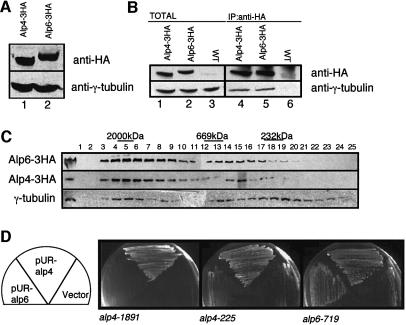Fig. 2. Physical and genetic interactions between Alp4/Alp6 and γ-tubulin. (A) Identification of the alp4+ and alp6+ gene products. Immunoblotting was performed with anti-HA antibody against cell extracts prepared from an Alp4-3HA (lane 1, LV15) or Alp6-3HA strain (lane 2, LV16). Gtb1 (γ-tubulin) was used as a loading control. (B) Physical interaction between Alp4/Alp6 and γ-tubulin. Cell extracts were prepared from an Alp4-3HA strain (lanes 1 and 4, LV15), an Alp6-3HA strain (lanes 2 and 5, LV16) or an untagged wild type (lanes 3 and 6), and immunoprecipitation performed with anti-HA antibody (lanes 4–6). Precipitated proteins were detected with anti-HA or anti-Gtb1 antibody. Total cell extracts (corresponding to 1/50 amount used for immunoprecipitation) were also run (lanes 1–3). (C) Gel filtration chromatography. Soluble cell extracts were analysed by immunoblotting with anti-HA or anti-Gtb1 antibody. Total extract (10 µg) was run in the far-left panel. Protein extracts from two strains (Alp4-3HA and Alp6-3HA) were loaded on separate columns, and separation profiles were superimposed according to a control pattern using anti-Gtb1 antibody. The positions of size markers (2000, 669 and 232 kDa) are also shown. (D) Suppression analysis by multicopy plasmids. ts alp4 or alp6 mutants were transformed with an empty vector or multicopy plasmids containing alp4+ or alp6+ (pUR-Alp4 or pUR-Alp6, respectively), and transformants were streaked on rich plates and incubated at 36°C for 3 days.

An official website of the United States government
Here's how you know
Official websites use .gov
A
.gov website belongs to an official
government organization in the United States.
Secure .gov websites use HTTPS
A lock (
) or https:// means you've safely
connected to the .gov website. Share sensitive
information only on official, secure websites.
